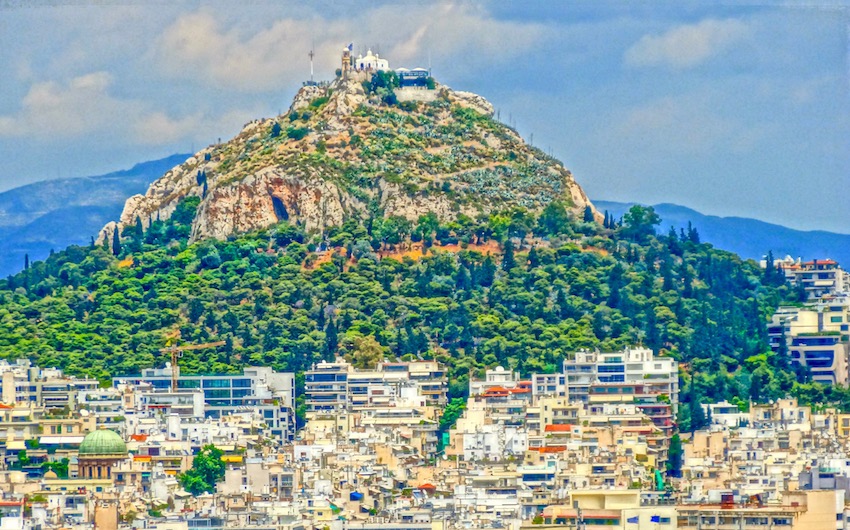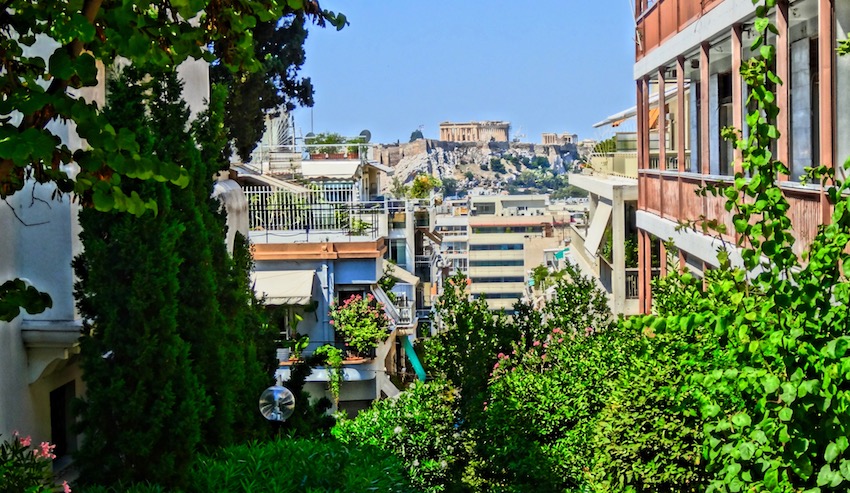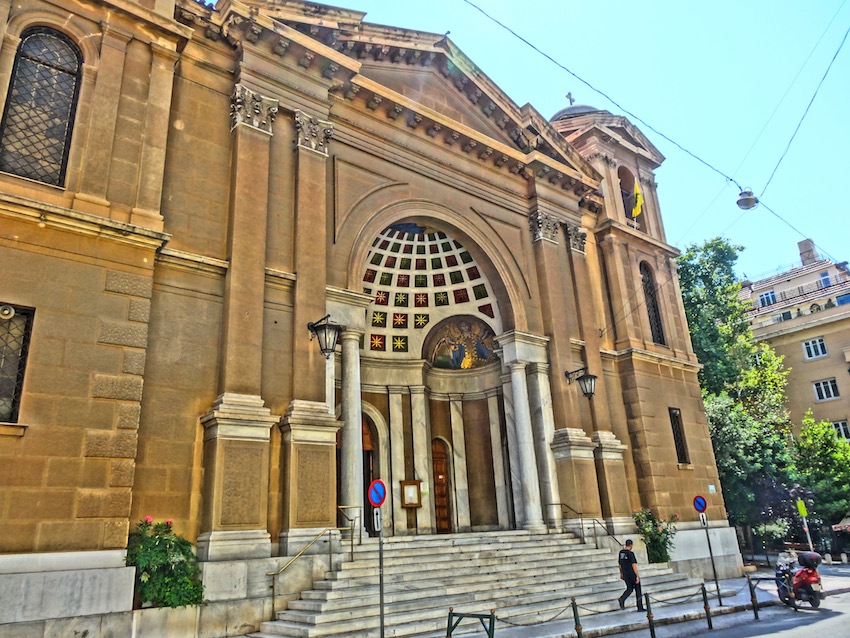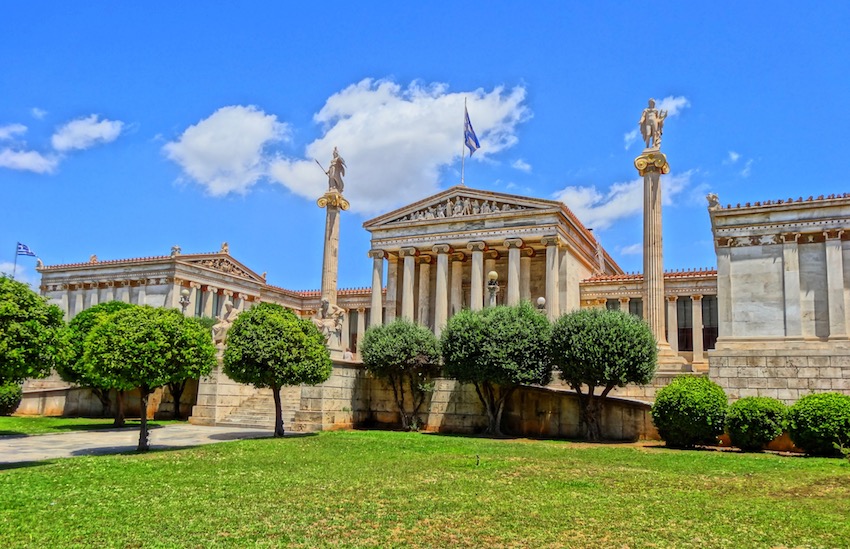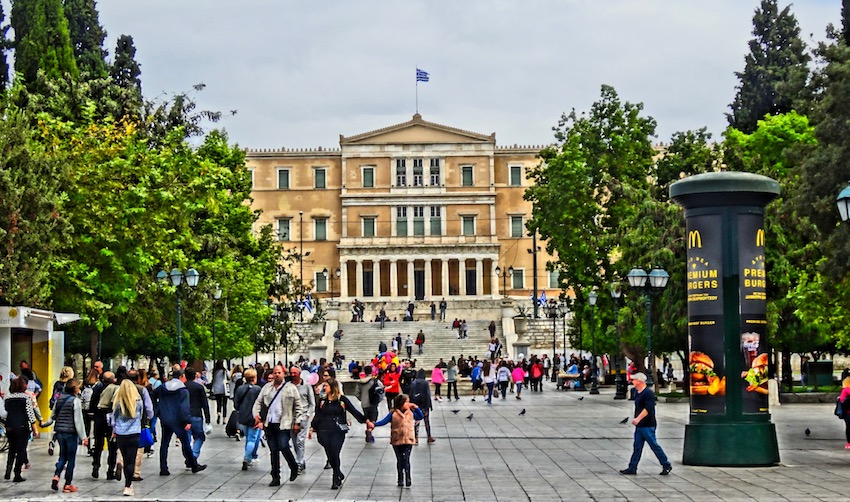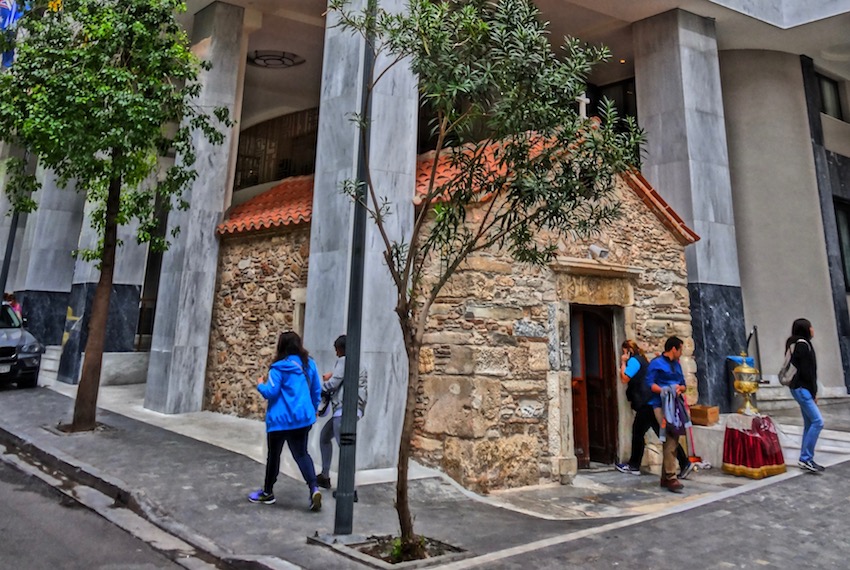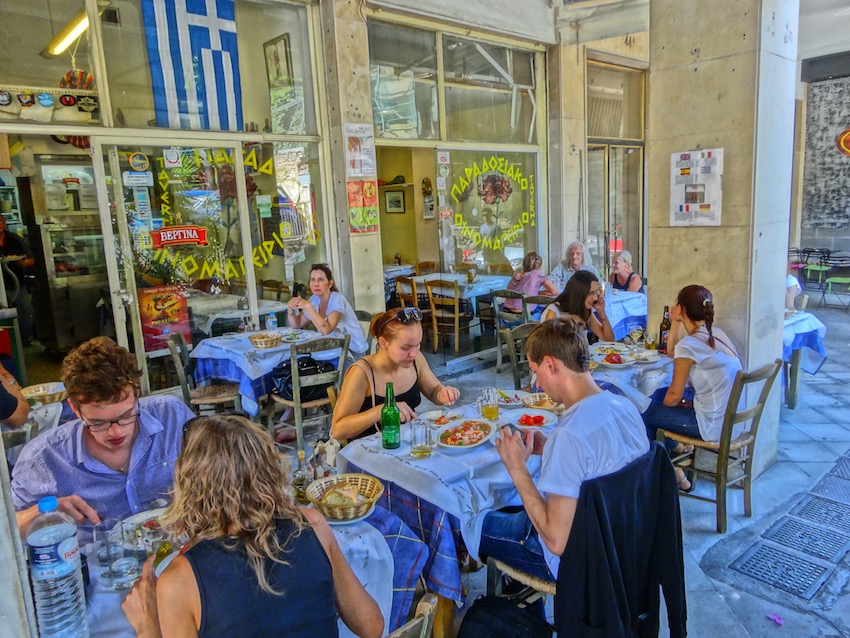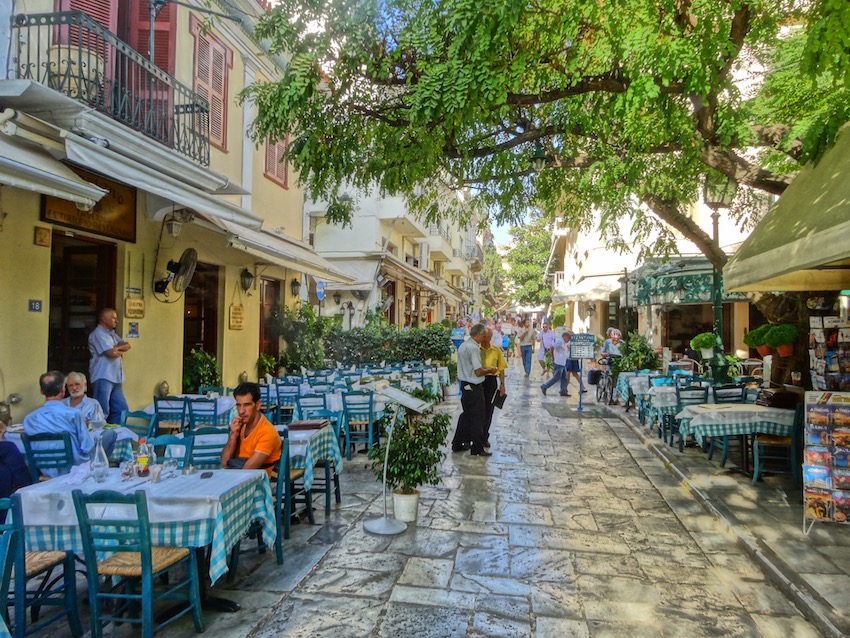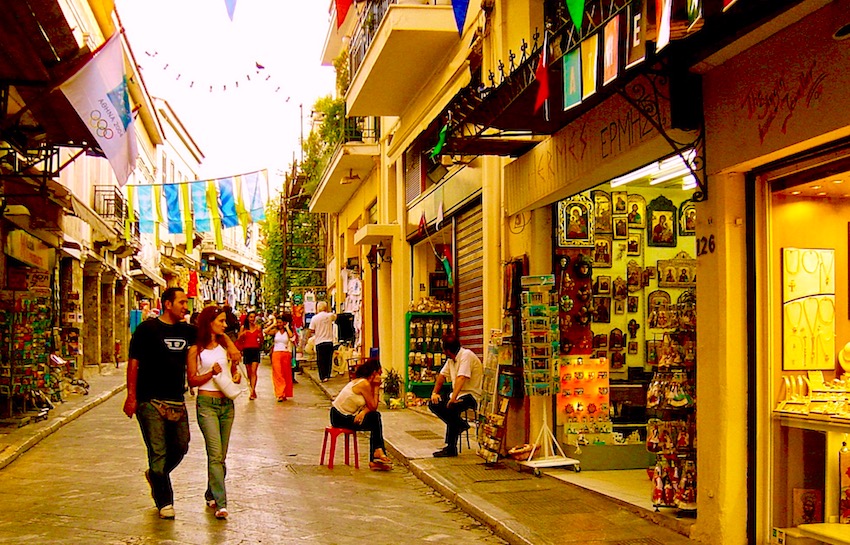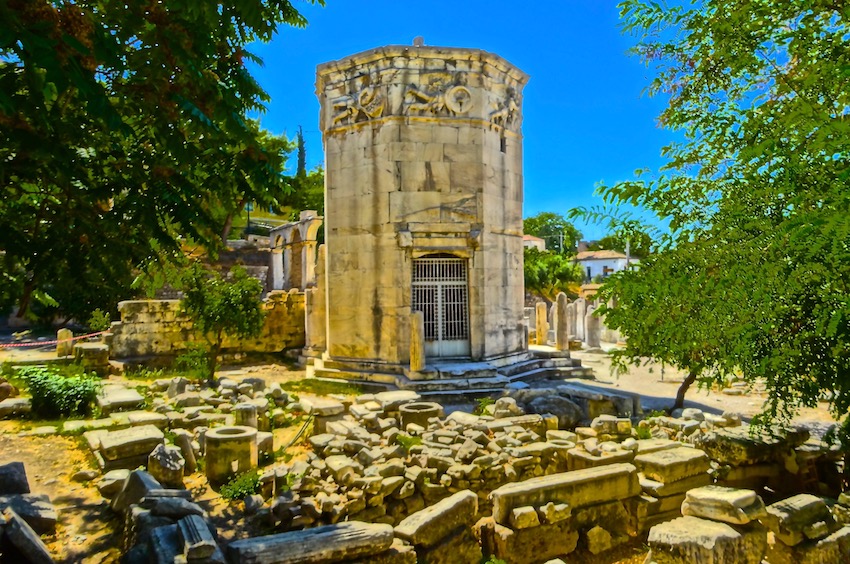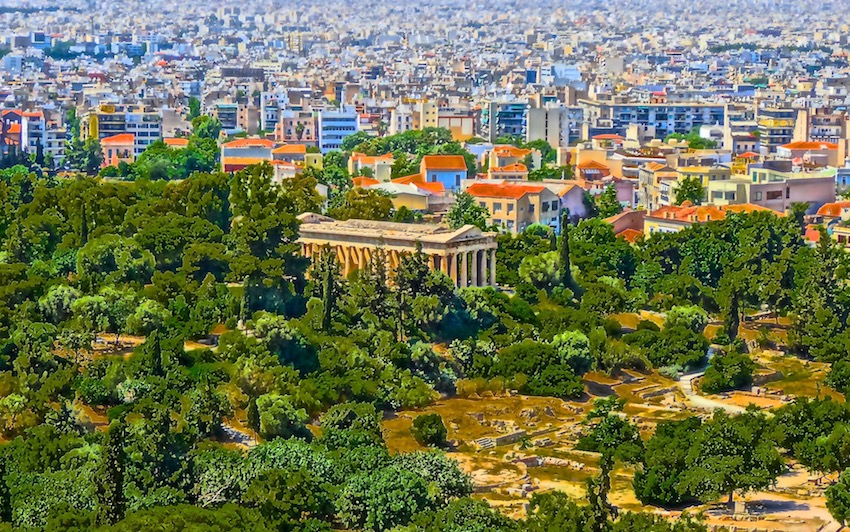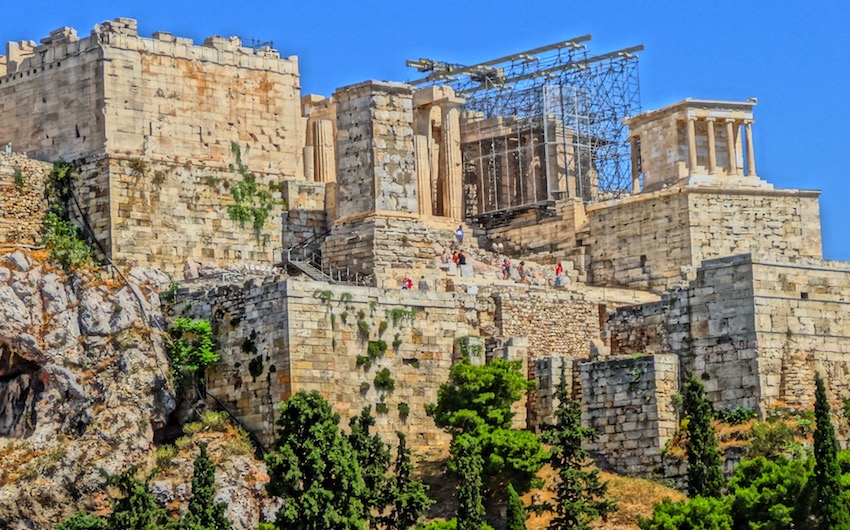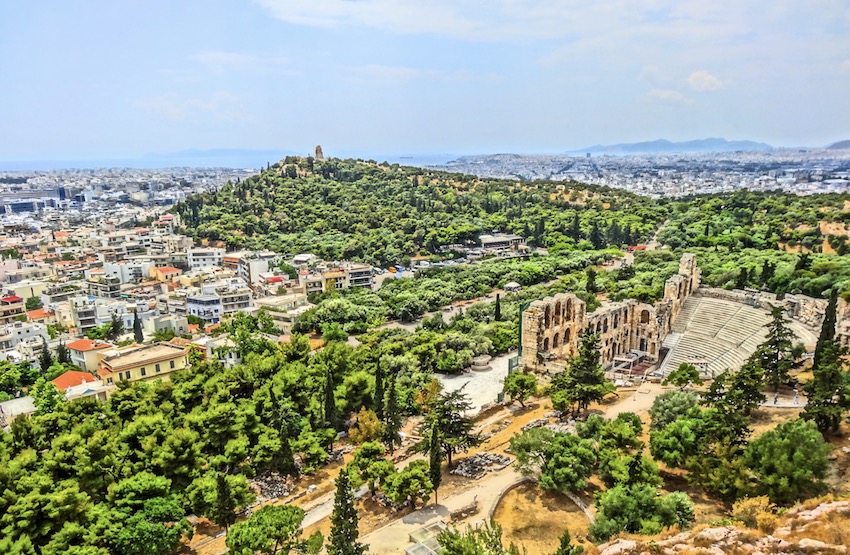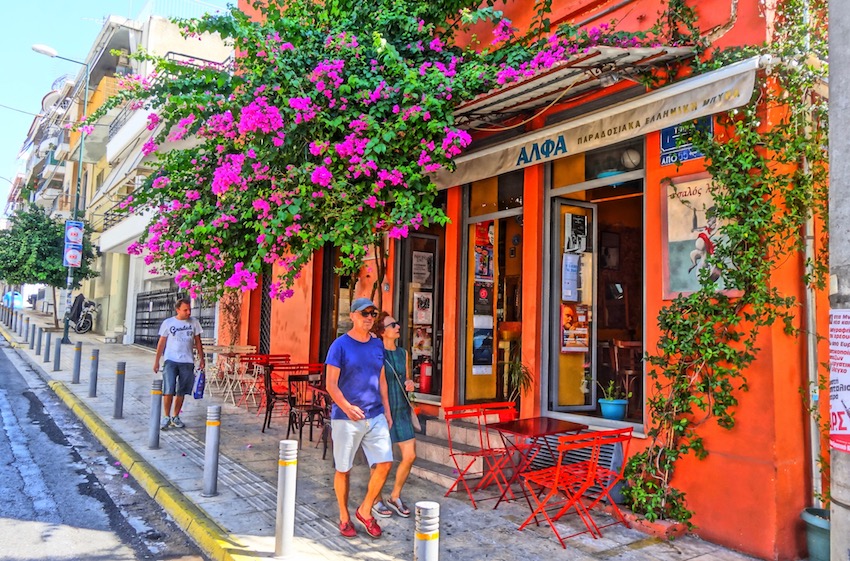
Hiking in Greece
Sunday in Athens Walking Tour
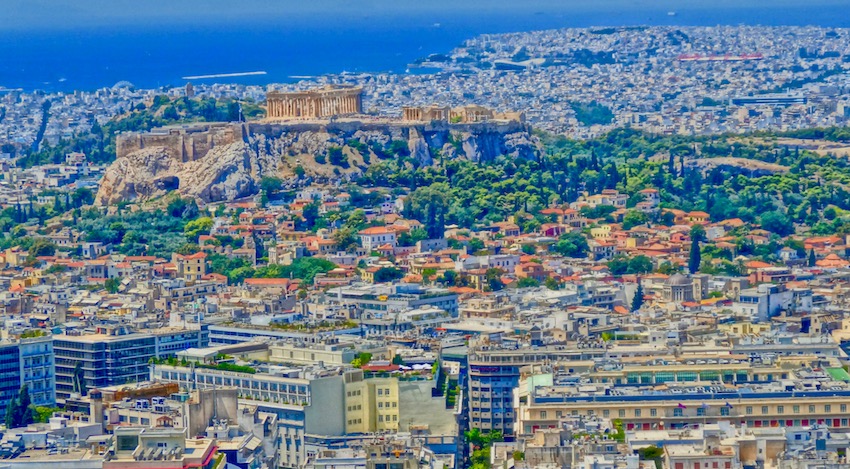
|
For those who like having stuff to do on Sunday here is a wonderful stroll from the top of Lykavittos hill to Petralona, a neighborhood on the south slope of Philopappou Hill,taking an hour or so, depending on how slowly you walk and whether or not you visit the Acropolis By Janet McGiffin Sunday morning in Athens is the city at its best. It’s quiet, calm and the air is clear. During spring and summer, that’s because most Athenians leave for the weekend! But fall and winter are equally pleasant because the hordes of commuters stay in the suburbs with their cars, leaving Athenians to enjoy their city. They bundle up grandma and the children and stroll through the streets and parks, chatting with friends, and settling into tavernas for an all-family lunch. A wonderful Sunday stroll is from the top of Lykavittos hill to Petralona, a neighborhood on the south slope of Philopappou Hill. It takes an hour or so, depending on how slowly you stroll. You walk as the crow flies, nearly, with the Acropolis ahead of you in sight most of the way—down through the fancy Kolonaki shops, past Syntagma square, through the Plaka (old city), over the top of the Acropolis (Free entrance into archeological sites on Sundays in the winter!), down the other side, up Philopappou Hill, and down into Petralona—in time for an old-fashioned Greek Sunday lunch. Along the way are vistas of the Acropolis, the sea, and Athens all around you—made more pleasureable by the lack of cars. One can hear birds! So get up about 9:00 or 10:00 on a Sunday morning, and take a taxi to the Lykavittos teleferik (Funicular) on Aristippou Street. Ride to the top. It’s five Euros round trip, every half hour from 9:00 a.m. to 3:00 a.m. Today, however, purchase a one-way ticket, since you’ll be enjoying the walk down. Or ask your taxi driver to take you up Lykavittos hill near the theatre. A path by the gazebo will lead you to the top. |
|
|
|
At the Lykavittos summit is a café which is usually open Sunday morning (But, that’s the charm of Athens—nothing is for certain). Even without a cappuccino in hand, you can enjoy the 360 degree view of the 6 million or so inhabitants of Athens, most of them sleeping at this hour on Sunday. From the steps in front of the Church of Profitas Elias (Prophet Elijah), you can spot the landmarks of today’s route: Syntagma Square, Plaka, Acropolis, Philopappou Hill monument. Your final destination is just beyond that monument. |
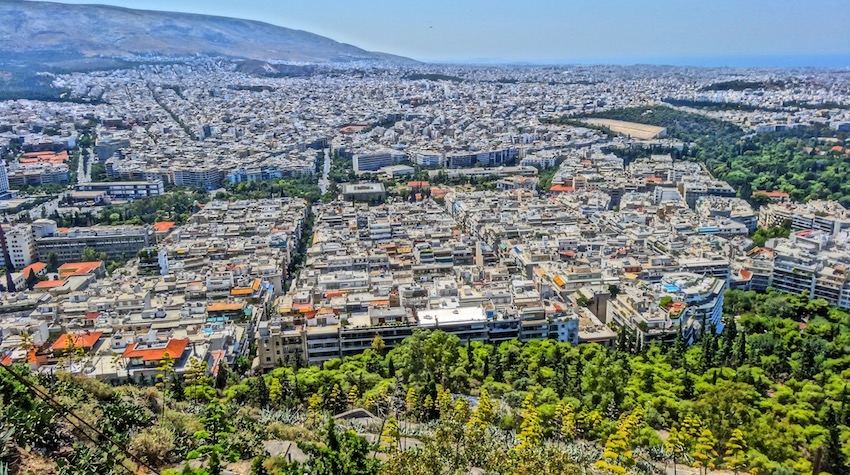 |
|
Legend says that Lykavittos hill happened when the goddess Athena, carrying a boulder which was to form the Acropolis, fumbled it. A lump fell from her hands and became Lykavittos . The name means “way of the wolf” because this hill was a wolf sanctuary when ancient Athens was clustered around the Acropolis. The church on top, Profitas Elias, has borne the names of several saints. Unlike most churches in Greece, it doesn’t sit over the ruins of a pagan shrine. The Byzantines planted olive trees here, and the present pine trees were planted in the 1800s. Tragically, their days are numbered. Marchalina hellenica (Gennadios P.), an insect that lives in the cracks and under the scale of bark of pine trees, is weakening the trees, leading to their death. The Greek website, Friends of the Trees, explains how the Greek Ministry of Agriculture in 2000 promoted the spread of this insect to increase the sticky excretions of the pine trees in order to help the bee industry. |
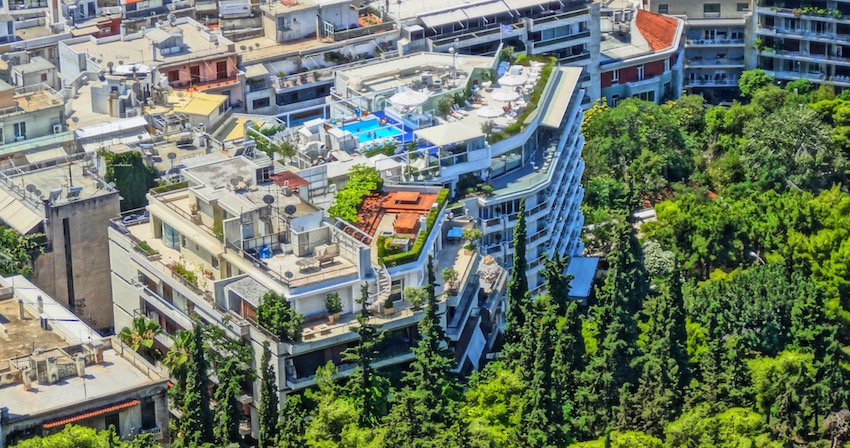 |
|
Now we start the walk. The steps on the south side of the church become a zig-zag path downward. (The sunset views from this path are well worth a return.) At the bottom, the path becomes steps which end at Kleomenous Street in the neighborhood called Kolonaki. Most streets here are named for heroes of the revolution against the Ottoman Turks. Bitter orange and lemon trees line the streets and apartment rents start at 500 Euros and go into the many thousands a month, depending on size and view. On Kleomenous Street, turn Right. In a minute you are in front of the St. George Lycabettus Hotel on your left. Hugging the hotel, go down the steps in front of the St. George, to the Left. At the bottom of the St. George steps, cross the street, go Left only a few paces, and immediately turn Right. You are walking through trees down a sloping pedestrian walkway lined with café tables, an excellent spot for a morning coffee if the café is open yet. (Excellent restrooms.) |
|
|
|
At the bottom of the sloping walk is Plateia Dexamini, the rendez-vous and playground for the surrounding neighborhoods. Dexamini means Reservoir, and two reservoirs are somewhere under your feet, one built in 25 AD by Hadrian, and the other in the 1800s. On your right is an open-air theatre which shows films spring through fall. Cross the plateia toward the steps on the far side, going straight. |
|
|
|
At the top of the steps, you see the Acropolis, a view which you will keep until you reach Syntagma Square. Proceed down the steps. At the bottom, turn Right. You are on Fokylidou Street, street of elegant apartments, home design shops, dress boutiques, and galleries. The rocky slope looming in the near distance is an arm of Lykavittos Hill. When you reach the second set of steps leading to the left, you are on Voukourestiou Street. Turn Left, down the steps. We will follow Voukourestiou to Syntagma Square, so you can pocket this walking guide for a bit and do some serious window shopping. You are strolling down through the most high-fashion and expensive shopping district in Greece. Shops are closed on Sunday, but the windows still glitter. Tsakaloff, the next cross-street, is said to be the most expensive of all for rent and prices. Ministers live here. Kolonaki Square is three blocks to your left on Tsakaloff. Continue downward. Cross Skoufa Street. |
|
|
|
On weekdays, Skoufa is clogged with traffic and noise. To the right two blocks is the large beautiful church of Aghios Dionissios, worth a detour on a Sunday morning. Past the church are jewelry shops, many cafes, and eventually the Exarchia neighborhood and university district. Continue on Voukourestiou, downward. You are passing big name shops now—Burberry, Arche. Cross Solonos. Solonos is a major traffic arterial toward the National Archeological Museum and Patission. On weekdays, it is so thick with fumes that you can see the air. Sunday morning, however, you can hear leaves rustle in the plane trees. Ahead, the shops on Voukourestiou get even more expensive: Bianca Verti, La Casa de Habano, Laura Ashley, Karen Millen. Now you have reached Akadamias Street. To the right is the Academy of Athens and the Cultural Center for the City of Athens. Cross Akadamias. Now, Voukourestiou becomes a pedestrian walkway. The fancy shops intensify: Baccarat, Louis Vuitton. On weekdays, the pedestrian walkways leading off Voukourestiou here are jammed with café tables filled with people enjoying a beverage or snack outdoors, even in winter. Sunday morning, nothing stirs. Continue downward. |
|
|
|
Pass Bang & Olufsen, Tod’s, Rolex, and the Lalounis Jewelry store across from Ralph Lauren. The block finishes at a street officially named Venizelou Eleftherion, known as Panepistimiou Street (University). Look left and you’ll see the green plantings of the Parliament Building on Syntagma Square. To the right are the beautiful Greek National Library and University of Athens. Cross Panepistimiou Street. Voukourestiou continues as yet another pedestrian walkway. You’re between theatres now, producing plays during theatre season. On the right is the momentous façade of the recently remodeled Pallas Theatre. Under its arcade is the Italian coffee shop Clemente VIII, so named because of this pope fondness for coffee. The building on your right covers an entire city block and is now the Attika Department store, the largest in Greece and the building is an historic neo-classic landmark. |
|
|
|
Your next cross street is Stadiou. On weekdays, the traffic roar and noxious fumes are overwhelming. But on Sunday, only a few cars straggle up from Omonia Square to Syntagma Square. Cross Stadiou. Turn Right. Go only a few steps. Then turn left. Enter an inside passageway called “Stoa Pagou Kalliga”. The stoa curves and brings you to the corner of Syntagma Square with a lovely view of the Parliament Building. Cross the street to the news stand (“periptera” in Greek). Turn Right. You are now inside the where stood the ancient walls built by Themistocles after the defeat of the Persians in 479 BC. Walk down Kagageorgi Servas Street two blocks to Voulis Street. Turn Left. |
|
|
|
Voulis Street crosses the downtown shopping district. Shops are closed on Sundays but plenty of families are strolling these streets on Sundays, enjoying the lack of cars on Ermou Street, on block ahead. To the left is a lovely view of the Parliament. To the right is Monastiraki Square, not visible from here. However, there is a lovely view of the hills surrounding Athens. Ermou used to be clogged with traffic and fumes but now it is pedestrian walkway nearly from Syntagma Square to Gazi, the old gasworks neighborhood past the trendy Theseio. Gazi now also sports bars and restaurants. A final portion of the pedestrian walkway is yet to be finished between Monasteraki and Theseio. Cross Ermou. |
|
|
|
Continue down Voulis Street. At Mitropoleos Street, look to the right. You can see the bell tower of the Orthodox Cathedral (Mitropoli) surrounded by a café-lined square. Near at hand, however, is a tiny chapel perched on the sidewalk under the Hotel Electra Metropolis. The chapel of Aghia Dynamis (Holy Power of the Virgin) is a 16th century chapel which belongs to the Holy Monastery of Assumption at Pendeli. Every day, a steady stream of the devout drop in to light a candle and kiss an icon. Step inside for a minute to view the lovely icons and inhale the incense. |
|
|
|
Return to Voulis and continue on through the travel agencies. The buildings on either side may look dull but the upper apartments have magnificent Acropolis views. Cross Apollonos Street, street of Orthodox supply stores with icons, incense burners and the brocade vestments for priests and lots of cafes and bars. At the next street, Nikodemou, look right at the apartment building with the trees on the top. Local rumor says it is the site of the home of Peracles, king of Athens, who presided over the construction of the Parthenon in 350 BC. On the corner is the famous Eugenia's Paradosiako restaurant which is popular with locals and tourists. Follow Voulis ahead into the Plaka. Voulis ends in one block at Kydathiaiou Street. Turn Right. |
|
|
|
You are on Kydathiaiou Street. Behind you, a few minutes walk is the Anglican Church of St. Paul. To your right, across from the Folk Art Museum is the lovely Orthodox church of The Transfiguration of the Virgin, 11th century, popular for weddings and baptisms, usually open only on Sundays. Peek inside at the smoky dark icons. Continue down Kydathiaiou Street a block to the central square of the Plaka. By now, the cafes ringing the square are filling up. It’s a nice spot to find a chair in the winter sun and sip a coffee while watching the passersby. When your legs are ready to go on, continue in the same direction you were going, past the Cine Paris, an outdoor cinema in the summer with spectacular views of the Acropolis. At the next junction, Adrianou Street, turn Right. |
|
|
|
Adrianou Street is lined with tourist shops which open around 10:30 on Sunday. After a long block, you will come to an intersection with four streets. Take the Left street, Flessa Street. Go uphill on Flessa Street. The Acropolis rises ahead of you. On Lysiou Street, turn Right. |
|
|
|
The red lines on Lysiou Street guided competitors during the 2004 Olympic Games. Follow these lines past the cafes, enjoying aroma of coffee. You are entering the residential neighborhood of the Plaka, where homes cost a million Euros and upwards. Pass St Spyridon Church. The lines on Lysiou stop at the end of the street. Pause a moment to look at the Tower of the Winds inside the Ancient Roman Forum. The tower was a clock water tower in ancient times, fed by water from an aqueduct off the Acropolis. The Tower is also a sundial, as can be seen by the short poles jutting from the top. Archeological sites are free on Sundays in the winter, so consider a detour. Or continue on. Standing at the end of the lines on Lysiou Street, turn Left. |
|
|
|
Go up the hill on Markou Avrikiou one block until the church of Kolimesis Theotokou ends the street. Turn Right. You are on Thrasivoulou Street. Follow this lovely winding lane, ogling the million-Euro homes with their spectacular views of Athens and the Acropolis from their gracious roof terraces. When the street ends, turn uphill towards the Acropolis, Left. You are skirting the Ancient Greek Agora (Market) to the right. Climb the steps past the Fine Arts School and the Folk Art Museum. At the top of the stone steps, ancient fortifications loom over you. Turn Right. |
|
|
|
Now you are on the ring road circling the Acropolis. Below you on the right is the Ancient Greek Agora and beyond it, a long vista of Athens climbing the northwestern hills. This road will take you to the gates of the Parthenon. The site is free on Sunday (or it was), so take a pleasant detour and join the throngs of chatting Athenians with children in tow visiting the temple of their ancestors. (If you need a toilet stop, the public facilities are well kept and are located down three steps just past the entrance.) After your tour of the Parthenon, continue the same direction you were going. Go down the steps on the other side of the Acropolis. Half way down, a stone path leads to the Right. Turn right onto the stone path. Follow the stone path through olive trees and chirping birds. At the bottom, go straight! |
|
|
|
Your goal is the stone road straight ahead, leading away from you through a forest. So pass through the bus parking lot, crossing the wide street that leads down to the right to Theseio. Pass the news stand (periptera) on your right. Now you are on the stone paved road lined with stone benches and leading into the forest of olive and pine trees of Philopappou Hill. Let your ears lead you towards the music of a priest, chanting. He is inside the Church of Aghios Demetrios Loubardiaris. The church was built in 1460, although local legend says 11th century. There is a lovely café around it. |
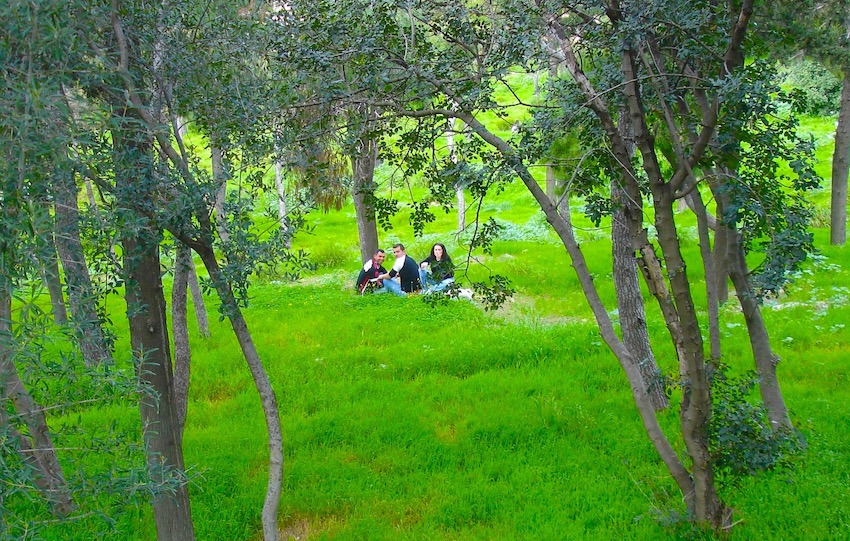 |
|
Legend says that Philopappou Hill /Hill of the Muses is where Socrates and his followers used to stroll to talk and view the Acropolis. The name Philopappou comes from a king of that name who ruled a small kingdom in SE Asia Minor. The memorial on top of the hill is to him, built in 114-16 during the reign of Trajan. A path across from the church leads to the monument. Or continue onward on this stone road as it curves to the Left.. Pass Kimon’s Tomb. The hill is also known as the Mouseion possibly from the Muses who may have had a shrine here. Or it was named for Mousaios, the companion of Orpheus. Pass the sign to the Dora Strattou Theatre. |
|
|
|
After about five minutes after the sign, you will see a broad gravel path leading off to the Right. Take this path. You are walking through olive groves on a slope dotted with white boulders and fallen marble pillars. You may see older people harvesting the wild plants beloved by Greeks—mushrooms, nettles, olives, or wild greens (horta), depending on season. In spring, the area is blanketed with wildflowers. Between the olive trees, you can glimpse the white houses of the Piraeus hill and the sea. After ten or fifteen minutes, you will arrive at a round gravel space. Stone steps lead left up to the Monument. More stone steps lead down to the Left. Follow the steps down. The steps become a dirt path, well structured. At the bottom is a wide opening in the iron fence. You have reached the gentrified part of Koukaki, where the old neoclassic homes are being refurbished. However, we are going to the neighborhood of Petralona. So when you reach the opening in the fence, turn Right. You are on a wide street that curves to the right. If you followed it, you would return nearly to where you were when you entered the Philopappou forest. Follow this road, but only for a minute or two. There is a small park on your left. A small residential street runs on the left side of this little park. Turn Left onto that residential street. Now you are in “Petralona”. The name of the street is at the far end of the block, Boutie Street. When you reach that sign, you are at the corner of Boutie and Roumelis. Turn onto Roumelis Street, Left. |
|
|
|
At the end of that block of Roumelis Street, you reach the main street of Petralona, Kolokotronis Street. Petralona is a working class neighborhood becoming gentrified due to its proximity to the expensive Theseio. Continue down Kolokotronis Street as it curves through Petralona. You will pass a mysterious archeological site below the street level on the right. Curve left. You are on Antaiou Street, going into a small square named Plateia Mercouri, a name known only by the locals since it isn’t posted anywhere. You’ve arrived at your destination! |
|
|
|
Now, look around for an open café or taverna. Follow your nose! It’s time to eat! When you are finished with your repast, leave the plateia continuing in the same direction as you were going when you entered the plateia. You are on Doreion Street, following under the electrical trolley lines. (There are two sets of trolley lines, so make certain you are on Doreion Street.) Continue straight on Doreion. In a few blocks, you will reach the electric train station called “Petralona”. Turn left towards the station, half a block. Buy a Metro ticket and get off at the closest stop to your hotel. When you get home, it will be time for the next Greek Sunday tradition—a nap. |
|
There are a number of excellent walking guides of Athens including: For more on Athens see Matt Barrett's Athens Survival Guide For organized walking tours in Athens see Athens-Walking-Tours and Athens Jewish Walking Tours Janet McGiffin lives in Athens partly because it is so easy to travel to anywhere from Greece. She is a writer of mystery novels and travel articles. She also writes grant proposals for non-profit organizations (NGO) based around the Mediterranean. Currently she is public-education publicist for a 24-partner European Union cultural project involving conservation of ancient monuments. You can e-mail her at janmcgiffin@yahoo.com |
Help Support Matt's Greece Guides
Do you enjoy using my site? Have you found it entertaining as well as useful? If so please show your appreciation by booking hotels through the travel agencies and the links found on my Hotels of Greece site. The small commission I make on the bookings enable me to keep working and in most cases you won't find them any cheaper by searching elsewhere.
You can find
hotels in Greece by location, price, whether or not it has a swimming pool, and see photos and reviews by using this link to booking.com which also contributes to my website when you book. If you are appreciative of all the free information you get on my websites you can also send
a donation through Paypal or Venmo
Join Matt Barrett's Greece Travel Guides Group on Facebook for comments, photos and other fun stuff. If you enjoy this website please share it with your friends on Facebook and other social media.
